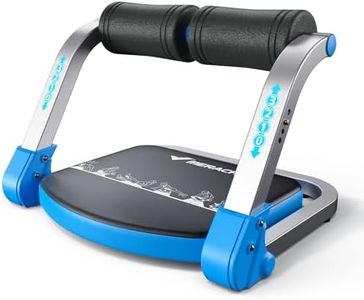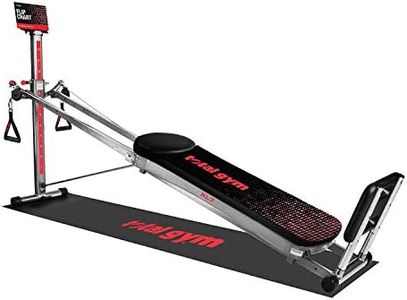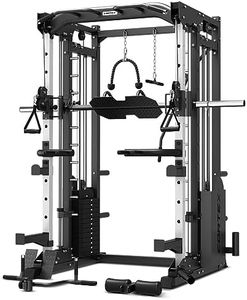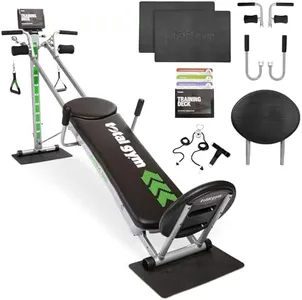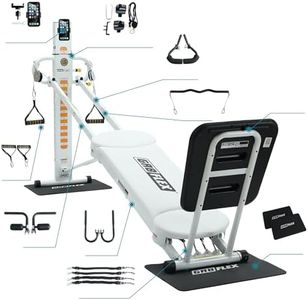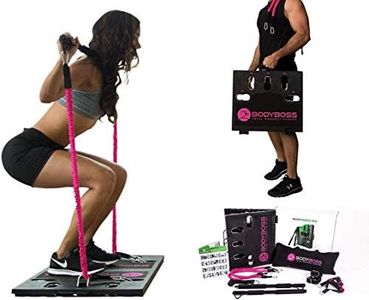We Use CookiesWe use cookies to enhance the security, performance,
functionality and for analytical and promotional activities. By continuing to browse this site you
are agreeing to our privacy policy
6 Best Total Gyms
From leading brands and best sellers available on the web.By clicking on a link to a third party's website, log data is shared with that third party.
Buying Guide for the Best Total Gyms
Choosing the right total gym (multi-purpose home gym system) can make a big difference in meeting your fitness goals comfortably and safely. To pick the best fit, you need to understand how you plan to use the gym, what types of exercises you want to do, and your available space. Look for features that match your fitness level and consider how much versatility you want in your workouts. Taking time to compare key specifications will help you identify a model that fits both your current needs and any future progression.Weight CapacityWeight capacity tells you the maximum user weight the machine can support safely. This is important for user safety and the longevity of the gym system because exceeding the limit can lead to equipment damage and injury. Weight capacities typically range from around 250 lbs to over 400 lbs. Lighter-capacity gyms are generally more compact but may be less stable, while higher-capacity gyms are sturdier and can accommodate a broader range of users. Choose a model where the weight capacity exceeds your own body weight, ideally with some margin, to ensure safety and durability.
Number of ExercisesThis specification lists how many different exercises the machine lets you do. More exercises mean more versatility and a better ability to target different muscle groups. Entry-level gyms may offer 20–30 exercises, while advanced models can exceed 80 or more. If you prefer variety or enjoy full-body routines, look for a gym that offers a higher number of exercises. Those with simple goals (like basic strength or rehab) may be satisfied with fewer options.
Resistance Mechanism & LevelsTotal gyms use either bodyweight, adjustable bands, or plate-loaded systems to provide resistance. This setting dictates how challenging exercises feel, and the number of resistance levels shows how finely you can adjust the challenge. More resistance levels provide smoother progression as your fitness improves. For beginners, a modest range is fine, but if you anticipate getting stronger or sharing the gym with others at different fitness levels, look for a model with more resistance levels and easy adjustability.
Footprint & FoldabilityThe footprint is the amount of floor space the gym takes up when set up, and foldability refers to whether it can collapse for easy storage. Larger gyms offer more features and stability but need more room, while smaller or foldable ones are ideal for tight spaces or shared rooms. Measure your available space before choosing and consider how often you’ll need to fold the machine away when not in use.
Assembly RequirementsSome gyms come almost fully assembled, while others need more involved setup. This can affect how quickly and easily you can start using the machine. Minimal assembly is great for those who want to avoid tools and setup hassles, while those comfortable with manual work can consider more complex systems. Check if the gym fits your preference for convenience versus customization.
Accessories and AttachmentsAccessories—like squat stands, wing attachments, pull-up bars, and ab crunch boards—increase the range of exercises you can perform. More attachments mean more options but can also take up extra space and increase complexity. If you know the types of exercises you like or have specific goals, look for gyms with compatible or included accessories.
Workout Guides and SupportSome total gyms come with workout charts, DVDs, or online support to help you learn exercises and build routines. Beginners benefit most from these guides, while experienced users might not need them. If you’re new to fitness or want structured progress, prioritize models that include instruction and ongoing support.
